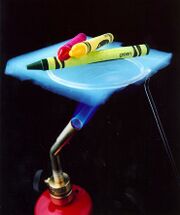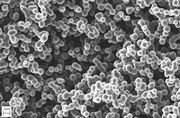Difference between revisions of "Aerogel"
| (20 intermediate revisions by the same user not shown) | |||
| Line 1: | Line 1: | ||
| − | + | [[File:Aerogel Supedium.jpg|thumb|Silica aerogel<br> Supedium [https://supedium.com/our-universe-space/the-incredible-aerogel/ Incredible Aerogel]]] | |
| − | + | [[File:Aerogelcrayons NASA.jpg|thumb|Crayons on aerogel over flame<br>NASA: [https://solarsystem.nasa.gov/stardust/tech/aerogel.html Aerogel]]] | |
| + | [[File:Aerogel structure.jpg|thumb|Aerogel Structure (Silica)<br>[https://www.dlr.de/mp/en/desktopdefault.aspx/tabid-4961/11054_read-25264/ Institute of Material Physics in Space]]] | ||
==Description== | ==Description== | ||
| − | + | Any synthetic, open-celled solid foam that is composed of a network of interconnected nanostructures. Aerogels are derived from gels in which the liquid has been replaced with gas while retaining the structure of the solid framework. The first aerogel material was created the Samuel Kistler in 1931 using silica gel (patented 1937). The unique properties of aerogels are due to its high surface area and open porous structure that provides extremely low density, as well as low thermal and sound conductivities. Although aerogels may feel fragile to the touch, they have strong structural integrity. They have been used in solar cells, fuel cells, batteries, supercapacitors as well as more mundane things such as paints, cosmetics, coats, rugs, pipes, spill-clean-up kits and insulation. Of particular interest for museums is the aerogels extrodinary ability to minimize heat transfer when used in fire protection blankets (Praestegaard 2023). | |
| − | |||
| − | |||
| − | |||
| + | Aerogels were first, and most commonly, made from silica (see [[aerogel, silica]]), but they are also been made from: | ||
| + | * Natural polymers: [[cellulose]], [[agar]] (SEAgel), [[gelatin]], [[pectin]] | ||
| + | * Synthetic polymers: [[Phenol formaldehyde resin|phenol-formaldehyde]], [[polyacrylate]], [[polystyrene]], [[polyurethane]], [[epoxy]], [[polyimide]] (AeroZero) | ||
| + | * Metal oxides: iron oxide, [[tin oxide]], lanthanide, actinide | ||
| + | * Carbon: carbon nanotubes | ||
| + | * Metals: [[gold]], [[copper]] | ||
| − | + | == Synonyms and Related Terms == | |
| + | aerogel; air glass; frozen smoke; blue smoke; solid air; solid cloud | ||
| − | + | Brand names: Santocel (obsolete); Pyrogel; Nanogel; Cryogel; Spaceloft; AeroZero | |
| − | |||
| − | |||
| − | |||
| − | |||
| − | |||
| − | |||
| − | |||
| − | |||
| − | |||
| − | |||
| − | |||
| − | |||
==Applications== | ==Applications== | ||
* Fire protection | * Fire protection | ||
* Thermal and sound insulation | * Thermal and sound insulation | ||
| − | * | + | * Thickening agent |
| + | * Collection of dust in outer space | ||
==Risks== | ==Risks== | ||
| + | * Structurally strong but can shatter like glass | ||
| + | * Will dissolve in water unless chemically treated | ||
| + | |||
==Physical and Chemical Properties== | ==Physical and Chemical Properties== | ||
| − | * | + | * Particle size averages 2-5 nm |
| + | * Surface area: up to 1200 m2/g | ||
| + | * Pore size is usually 100nm | ||
| + | * Porosity greater than 50% with examples of 99.8% | ||
| + | * Density - 0.2 - 0.5 g/ml | ||
* Very lightweight | * Very lightweight | ||
| + | * Thermal conductivity = < 5 mW/mK (inert against molten metal) | ||
| − | ==Working Properties== | + | ==Working Properties== |
| − | |||
| − | |||
| − | |||
==Resources and Citations== | ==Resources and Citations== | ||
| − | * Praestegaard L., G. Sorig Thomsen, K. Woer 'Before the Fire: Experiments on Fire-Protecting Cover Materials', Studies in Conservation, | + | * Institute of Materials Physics in Space: [https://www.dlr.de/mp/en/desktopdefault.aspx/tabid-4961/11054_read-25264/ Aerogels] |
| + | * Praestegaard L., G. Sorig Thomsen, K. Woer 'Before the Fire: Experiments on Fire-Protecting Cover Materials', Studies in Conservation, 68(1), 1-8, (2023) [https://doi.org/10.1080/00393630.2021.1978227 link] | ||
* Alwin, S., Sahaya Shajan, X. Aerogels: promising nanostructured materials for energy conversion and storage applications. Mater Renew Sustain Energy 9, 7 (2020). | * Alwin, S., Sahaya Shajan, X. Aerogels: promising nanostructured materials for energy conversion and storage applications. Mater Renew Sustain Energy 9, 7 (2020). | ||
* Skanacid A/S: www.skanacid.dk | * Skanacid A/S: www.skanacid.dk | ||
Latest revision as of 10:44, 8 July 2023
Description
Any synthetic, open-celled solid foam that is composed of a network of interconnected nanostructures. Aerogels are derived from gels in which the liquid has been replaced with gas while retaining the structure of the solid framework. The first aerogel material was created the Samuel Kistler in 1931 using silica gel (patented 1937). The unique properties of aerogels are due to its high surface area and open porous structure that provides extremely low density, as well as low thermal and sound conductivities. Although aerogels may feel fragile to the touch, they have strong structural integrity. They have been used in solar cells, fuel cells, batteries, supercapacitors as well as more mundane things such as paints, cosmetics, coats, rugs, pipes, spill-clean-up kits and insulation. Of particular interest for museums is the aerogels extrodinary ability to minimize heat transfer when used in fire protection blankets (Praestegaard 2023).
Aerogels were first, and most commonly, made from silica (see Aerogel, silica), but they are also been made from:
- Natural polymers: Cellulose, Agar (SEAgel), Gelatin, Pectin
- Synthetic polymers: phenol-formaldehyde, Polyacrylate, Polystyrene, Polyurethane, Epoxy, Polyimide (AeroZero)
- Metal oxides: iron oxide, Tin oxide, lanthanide, actinide
- Carbon: carbon nanotubes
- Metals: Gold, Copper
Synonyms and Related Terms
aerogel; air glass; frozen smoke; blue smoke; solid air; solid cloud
Brand names: Santocel (obsolete); Pyrogel; Nanogel; Cryogel; Spaceloft; AeroZero
Applications
- Fire protection
- Thermal and sound insulation
- Thickening agent
- Collection of dust in outer space
Risks
- Structurally strong but can shatter like glass
- Will dissolve in water unless chemically treated
Physical and Chemical Properties
- Particle size averages 2-5 nm
- Surface area: up to 1200 m2/g
- Pore size is usually 100nm
- Porosity greater than 50% with examples of 99.8%
- Density - 0.2 - 0.5 g/ml
- Very lightweight
- Thermal conductivity = < 5 mW/mK (inert against molten metal)
Working Properties
Resources and Citations
- Institute of Materials Physics in Space: Aerogels
- Praestegaard L., G. Sorig Thomsen, K. Woer 'Before the Fire: Experiments on Fire-Protecting Cover Materials', Studies in Conservation, 68(1), 1-8, (2023) link
- Alwin, S., Sahaya Shajan, X. Aerogels: promising nanostructured materials for energy conversion and storage applications. Mater Renew Sustain Energy 9, 7 (2020).
- Skanacid A/S: www.skanacid.dk
- Supedium: The Incredible Aerogel
- Wikipedia: https://en.wikipedia.org/wiki/Aerogel
- Aerogel: What is Aeogel?


